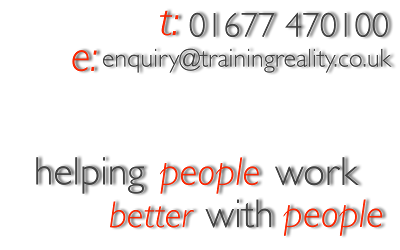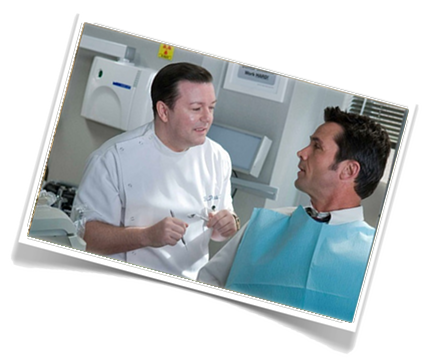Please press (at least!) one of these.
It costs you nothing, and (possibly) helps us spread the word!
Customer Service - Part 2
Friday, 4 September 2009
Last week, I wrote about the power of the little things that make the difference between good and exceptional customer service (see here). These little things alone are not enough to deliver excellence, but they are the things that make you stand out to your customers, and persuade them to act as your free marketing ambassadors - the best publicity you can possibly have.
The challenge with training customer service and improving service standards to this level is that it is both impossible to list every single thing that will make the difference, let alone ensure that the staff you are training absorb and act on them all. That’s where a non-directive coaching approach to training (the sort that we at trainingreality use regularly) really comes in. Directive coaching or training in this context is simply inappropriate and not effective. Coaching that is about staff thinking for themselves and adapting to each and every situation in a unique way is.
One of the most powerful training techniques we use is to question, deeply and thoroughly, the situation from the other’s perspective. Whether that perspective is right or wrong is (for the time being, at least) utterly irrelevant - what is important is to see things from as many angles as possible, in order to open up the range of possibilities, thereby widening the potential courses of action available.
Once we’ve done this (at a practical level, using experiential outdoor activities and group work, as well as sessions in the classroom), we explore how this is translated into practical, applicable benefit back at work.
To take the examples from the previous customer service blog:
1) The HP Sauce Challenge
My guess (and I’m happy to admit, it is a guess) is that the waitress was asked to deliver some HP Sauce to a particular table, and so that is exactly what she did. Following specific and highly generalised instructions is one major and regular downfall associated with missing the opportunity to delight the customer. There are two routes to explore in how to deal with this in a long-term, sustainable way.
a) The first challenge is for the manager in the situation. Their challenge is to give enough information to lead to the behaviour and outcome that they want. If the manager in this case had said “the gentleman on table X would like some HP Sauce for his sandwich”, that might have been enough for the waitress to become aware that, as someone eating a sandwich, I was unlikely to have had cutlery at my table.
b) The second challenge is for the waitress herself. She could have asked (either to her manager, or simply in her head) why I might have wanted it. That way, she would have started to put herself in my shoes, maybe have glanced over to the table, and (as mentioned in the last blog entry about this), used powerful observation to read the situation and act accordingly.
2) The Tesco Slippery Floor
Again, my guess is that the action I observed was a quick, simple, and reactive action, rather than a carefully considered piece of customer service. Speed appeared to be more of a concern in this situation - the supervisor was on her way to somewhere else, and made the comment in passing. The challenges here are:
a) Being aware of every single opportunity to deliver great customer service. If you’re communicating with a customer (or potential customer), do it from the perspective of wanting to impress them - every time.
b) Slow down a little, and you’ll become much more aware of all the opportunities that present themselves. As with the powerful NLP filters system, it’s amazing what you notice when you’re actively looking for it, and what you don’t notice when you’re not.
---
The way we approach this training need is to recreate past customer service situations, invent and experience new ones, and imagine the future, so that not only is awareness raised to a much higher level, our delegates actually begin to experience the direct benefits of slowing down, being more aware, taking in more information and sharing useful details, so that it becomes in their interests to continue doing so.
A great, positive example to finish on - and one that has caused me to recommend Booths supermarkets (http://www.booths-supermarkets.co.uk) to many, many people. I bought a DVD there a little while ago. In a rush to get home, I forget to wait until the actual DVD had been returned to me, and left the shop without it. On calling to ask if it was still there (I had paid for it!), I had even forgotten the exact name of the film I’d bought (Ghost Town, with Ricky Gervais - great film!). Despite this, the person I spoke to worked out what the film was, and promised to look into it and sort it out. Within three days, I not only got the film in the post from them, but it included a short, handwritten note from the lady who’d served me apologising and hoping that I was going to enjoy watching it. I’ve not stopped being an ambassador for Booths since.
Please press (at least!) one of these.
It costs you nothing, and (possibly) helps us spread the word!





